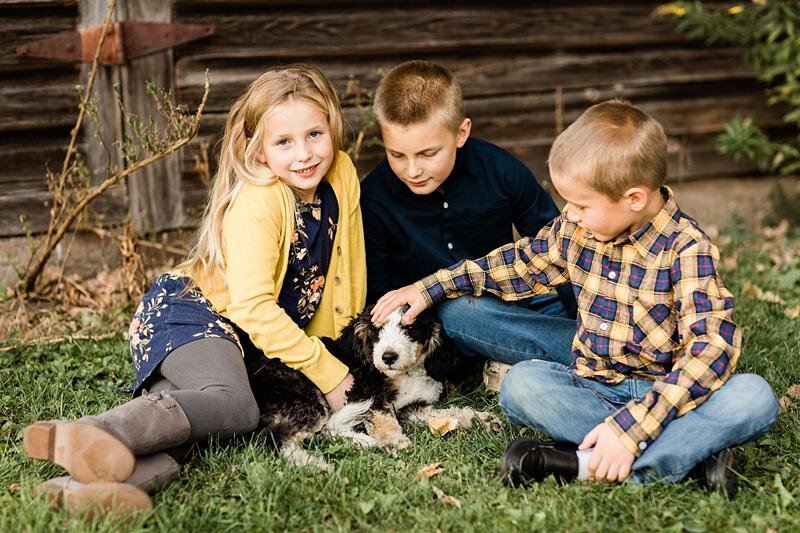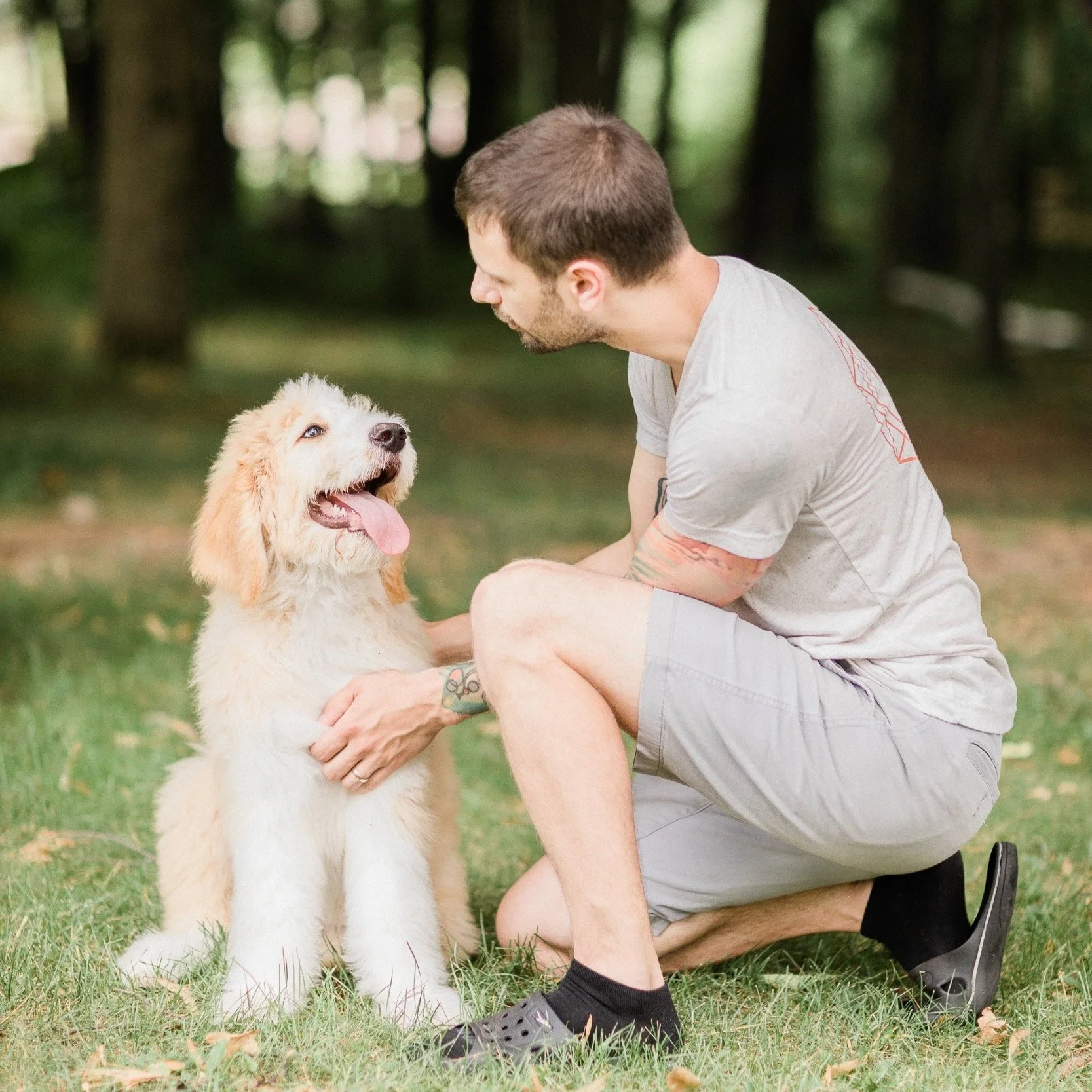What is a Reverse f1b Bernedoodle?
Reverse f1B = more bernese
“A Bernedoodle that is more Bernese than Poodle”
LEARN MORE ABOUT Reverse f1b BernedoodlES
F1b – First Generation Backcross or Reverse F1b:
Backcrossing is breeding a hybrid back to one of the breeds it originates from. The “b” in F1b Bernedoodle simply means bred back to a purebred parent. It can be from a purebred Poodle or a purebred Bernese Mountain Dog. Genetically, this means they're still first-generation.
Backcrossing Bernese Mountain Dogs and Poodles serves several purposes in the realm of dog breeding, leading to the creation of hybrid breeds like Bernedoodles. The main reasons for backcrossing these two breeds are to combine desirable traits from both parent breeds, enhance certain characteristics, and address potential health concerns. Here's why breeders undertake this process:
Crossbreeding Bernese Mountain Dogs and Poodles is a popular practice among breeders due to the desirable traits of each breed. Bernese Mountain Dogs are known for their gentle nature and striking appearance, while Poodles are valued for their intelligence and hypoallergenic coat. By combining the two breeds, breeders aim to create offspring that embody the best qualities of both parents, resulting in dogs with a desirable temperament, appearance, and traits.
One of the main reasons for backcrossing Bernese Mountain Dogs with Poodles is to produce dogs with hypoallergenic coats. Poodles are known for their non-shedding, hypoallergenic coats, which makes them an ideal choice for individuals with allergies. By incorporating Poodle genetics into the hybrid breed, breeders aim to reduce shedding and dander, making these dogs more suitable for allergy sufferers.
Backcrossing allows breeders to manipulate the size and temperament of the resulting offspring. Bernese Mountain Dogs are larger, working dogs with a gentle disposition, while Poodles come in different sizes and are highly intelligent. Breeders can produce smaller Bernedoodles by selecting smaller Poodles for breeding. This approach also allows breeders to create dogs with a more compatible temperament for a particular household or lifestyle.
Breeding Bernese Mountain Dogs and Poodles together can result in hybrid vigor, which may lead to healthier offspring with fewer genetic health issues that affect either parent breed. This is because the genetic diversity of two different breeds can lower the chances of inheriting specific hereditary conditions. However, it's crucial for breeders to conduct health screenings and select parents with good genetic health to ensure the well-being of the puppies.
Backcrossing is a technique that allows breeders to introduce genetic diversity and reduce some of the genetic health issues present in both Bernese Mountain Dogs and Poodles. By carefully selecting parent dogs with fewer genetic health problems, breeders can work towards producing healthier offspring.
The Origins of Reverse f1b Bernedoodles:
The Reserve F1b Bernedoodle is a crossbreed of the Bernese Mountain Dog and the Poodle, created over several generations. These two breeds are known for their unique qualities, but the Reserve F1b Bernedoodle leans more towards the Bernese Mountain Dog lineage, offering a distinct combination. Through careful breeding, these dogs embody the best traits of their parents, achieving a perfect balance of size, appearance, and temperament.
The Reserve F1b Bernedoodle became popular as people wanted to emphasize the Bernese traits in their doodle lines while retaining the coat characteristics of the Poodle and first-generation doodles. At Stokeshire, we introduced Reserve F1b Bernedoodles & Reserve F1b Australian Mountain Doodles to the Midwest as top Doodle Breeders. By breeding our Bernese & Aussies with our multi-gen Berneoodle, Bowser, we've created these unique Doodle crosses.
Physical Features and Size of a Reverse f1B Bernedoodle:
Bernese Mountain Dog - Brigitta
Reverse F1B F1B Bernedoodles are known for their larger size, often leaning towards the Bernese Mountain Dog side. While there is individual variation, they typically fall within the medium to large size range. With robust chests, muscular bodies, and sturdy builds, Reverse F1B Bernedoodles exude a majestic presence. Their remarkable appearance is enhanced by a luxuriously dense, wavy, and occasionally curly coat that harks back to their Poodle heritage. Coat colors encompass a striking array, including black, white, brown, and tri-color patterns.
Temperament and Personality of Reverse F1B Bernedoodle:
Reverse F1B Bernedoodles inherit a delightful blend of traits from their Bernese and Poodle ancestors. Revered for their gentle and affectionate nature, they usually make loving and devoted family companions. Their intelligence shines, making them quick learners responsive to training. Although each Reverse F1B Bernedoodle has its distinct personality, they often display a friendly, sociable, and eager-to-please disposition. These dogs thrive on human interaction, relishing the company of their loved ones and forming strong bonds.
Exercise and Training Reverse F1B Bernedoodle:
Given their larger size and moderate to high energy levels, Reverse F1B Bernedoodles need regular exercise to stay mentally and physically engaged. Activities such as daily walks, runs, and secure playtime are beneficial for meeting their exercise requirements. Moreover, training sessions should be a consistent part of their routine, as Reverse F1B Bernedoodles possess sharp intellects and respond well to positive reinforcement methods. Early socialization and consistent training from an early age contribute to a well-rounded and obedient companion.
Grooming and Coat Care for Reverse F1B Bernedoodle:
The exquisite coat of a Reverse F1B Bernedoodle requires consistent grooming to keep it in top condition. The dense, wavy, or curly fur should be brushed several times weekly to prevent matting and tangling. Professional grooming sessions may be necessary to maintain coat health and aesthetics. Depending on the specific coat type, occasional trimming or shaving might also be needed. Additionally, routine upkeep, including dental care, ear cleaning, and nail trimming, should not be overlooked.
Health Considerations for Reverse F1B :
Reverse F1B Bernedoodles, like any hybrid breed, can benefit from potential health advantages arising from crossbreeding. However, it's crucial to be mindful of potential health issues that may affect both the Bernese Mountain Dog and Poodle breeds. Common health concerns to monitor in Reverse F1B Bernedoodles include hip dysplasia, elbow dysplasia, progressive retinal atrophy (PRA), and specific heart conditions. Our parents undergo health testing and come from verified pedigrees, aiming to ensure you receive the healthiest possible puppy.
Berndoodle as a Family Pet
Are Reverse f1B Bernedoodles trainable?
Reverse F1B Bernedoodles are unique in that they may exhibit a slower maturity rate compared to some other breeds. While they are generally intelligent and eager to please, their development and training may require additional patience and understanding.
Unlike some dog breeds that may reach maturity at a younger age, Reverse F1B Bernedoodles tend to take their time in growing both physically and mentally. This slow maturation process is a characteristic inherited from their Bernese Mountain Dog lineage. It's important for owners to be aware of this aspect and adjust their expectations accordingly.
During the training process, it is crucial to approach their development with patience and consistency. Here are some tips to navigate the slower maturity rate of Reverse F1B Bernedoodles:
Be patient and understanding: Understand that Reverse F1B Bernedoodles may take longer to grasp certain concepts or commands. Avoid rushing their progress and allow them the time they need to fully understand and respond to training.
Break down training sessions: Due to their slower maturity, it's advisable to break down training sessions into shorter, more frequent sessions. This approach helps prevent fatigue and keeps the dog engaged and focused.
Positive reinforcement is key: Reverse F1B Bernedoodles respond well to positive reinforcement techniques. Rewarding them with treats, praise, or playtime when they exhibit desired behaviors encourages them to continue learning and cooperating during training sessions.
Consistency is essential: Consistency is key when training any dog, but it is particularly important with Reverse F1B Bernedoodles. Establish clear rules and expectations and consistently reinforce them. This helps them understand what is expected of them and reinforces positive behavior.
For Reverse F1B Bernedoodles, mental stimulation is crucial. You can engage their intelligent minds with activities such as puzzle toys, interactive games, and training exercises. These challenges can help keep them engaged, reduce boredom, and aid in their overall development.
Socialization is also essential for these dogs. Properly introducing them to various environments, people, and animals from an early age can help develop their confidence, adaptability, and reduce potential stubbornness in new situations.
If you encounter difficulties in training or managing your Reverse F1B Bernedoodle's slower maturity, seek the assistance of a professional dog trainer or behaviorist. They can provide specialized guidance and techniques tailored to your dog's specific needs.
Remember that the slower maturity of Reverse F1B Bernedoodles is a natural part of their development. With patience, consistency, and positive reinforcement, you can guide them towards becoming well-rounded, obedient, and cooperative companions. Embrace their unique journey and enjoy the rewarding experience of training and nurturing a Reverse F1B Bernedoodle.
SEARCH FOR A PENDING BERNEDOODLE LITTER BELOW
- Green Eyes
- Wavy
- Brown & White
- Savi
- Cream
- Black Tri
- Apricot
- Buttercup
- Tri
- Black
- Phantom
- Blue Merle
- Loose
- Parti
- Apollo
- Fully Furnished
- F2
- Olive
- Medium
- Luna
- Mack
- Flat
- Daisy
- Red & White
- Toy
- Brown
- Mavi
- Multigen
- BI
- Large
- Standard
- Micro
- Furnished
- Curly
- Mini
- Mozzi
- Valli
- Emery
- Brown Merle
- Merle
- First Pick
- Blue
- Bi
- Chocolate
- Ultra
- Brown Tri
- Tri Merle
- Red
- Blue Eyes
- Nora
- F1B
- Improper Coat
- Chocolate Tri
- Unfurnished
- Red Merle
- Straight





